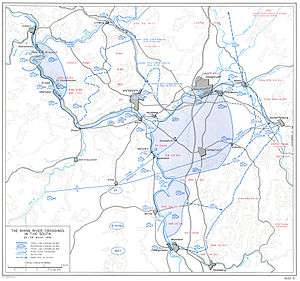History of crossings of the Rhine
The River Rhine forms a natural frontier and so the phrase Rhine Crossing, Crossing of the Rhine, or forcing the Rhine may refer to one of several crossings of it.
.jpg)
The crossing of the Rhine at Tolhuis (now a suburb of Nijmegen) on 12 June 1672 – painting by Adam Frans van der Meulen.

A 'passage of the Rhine' on the south facade of the porte Saint-Denis.
History
- the Crossing of the Rhine from east to west by barbarians in 406, into the territory of the Roman Empire
- several times by French troops invading Germany during the Franco-Dutch War, such as:
- 12 June 1672 near Tolhuis, commanded by the Vicomte de Turenne and Louis, Prince of Condé, in which Louis was severely wounded forcing the river crossing – this crossing was commemorated in the painting Crossing of the Rhine by the army of Louis XIV, 1672 by Joseph Parrocel
- 1673, led by Turenne
- from east to west by Charles Alexander of Lorraine in 1744 during the War of the Austrian Succession, as commemorated in Johann Tobias Sonntag's painting Duke of Lorraine crossing the Rhine before Strasbourg
- several times by French troops invading Germany during the French Revolutionary Wars:
- for the first time in 1794, near Düsseldorf
- on 6 September 1795, as commemorated in Louis-François Lejeune's painting First crossing of the Rhine by the French army commander by Jourdan and Kléber, at Düsseldorf in the duchy of Berg, 6 September 1795
- 18 April 1797, by French Revolutionary forces near Neuwied, causing to the Battle of Neuwied.
- Between 27 April and 2 May 1800, 100,000 men under Jean Victor Marie Moreau, crossing to confront the Austrians, who they then met at the battle of Stockach.
- from east to west by Prussian and Russian Troops invading France in 1814 near Kaub, as commemorated in Wilhelm Camphausen's painting General von Blücher Crossing the Rhine.
World War II

March 1945 : The crossings of the Rhine in the South
The crossing from west to east by the western Allies in March 1945 during the Western Allied invasion of Germany.
- Battle of Remagen - on 7 March by the First United States Army
- Nierstein Rhine crossing - on 22 March by the Third United States Army
- Operation Plunder and Operation Varsity – on 23-24 March. British units participating were granted the battle honour 'Rhine Crossing' by the British Army
- Boppard Rhine crossing - on 25-26 March by the Third United States Army, at Boppard and Sankt Goar
- Worms Rhine crossing - on 26 March by the Seventh United States Army
gollark: We know carbon dioxide went up/is going up, and temperatures also are, and there's a clear mechanism for CO2 causing temperature increases, and also Venus as a neat demo.
gollark: That... is irrelevant.
gollark: How would those cause carbon dioxide production?
gollark: Also, yes, we have good knowledge of the mechanism.
gollark: Except seriously how would that even work.
This article is issued from Wikipedia. The text is licensed under Creative Commons - Attribution - Sharealike. Additional terms may apply for the media files.